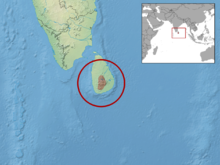| Lankascincus taprobanensis | |
|---|---|
| Conservation status | |
 Endangered (IUCN 3.1) | |
| Scientific classification | |
| Domain: | Eukaryota |
| Kingdom: | Animalia |
| Phylum: | Chordata |
| Class: | Reptilia |
| Order: | Squamata |
| Family: | Scincidae |
| Genus: | Lankascincus |
| Species: | L. taprobanensis |
| Binomial name | |
| Lankascincus taprobanensis (Kelaart, 1854) | |

| |
| Synonyms | |
Lankascincus taprobanensis, also known commonly as the Ceylon tree skink and the smooth Lanka skink, is a species of lizard in the family Scincidae. The species is endemic to the island of Sri Lanka.
Habitat and distribution
The smooth Lanka skink is found from 1,000 to 2,300 metres (3,300 to 7,500 ft) above sea level, and is the only skink found at the 2,300-metre (7,500 ft) elevation in Sri Lanka. It is common in the Horton Plains, Hakgala, Namunukula, and Nuwara Eliya.
Description
The body of L. taprobanensis is stout, and the length of the tail is 1.3 to 1.5 times that of the body. The fronto-parietals are distinct. The parietals are in narrow contact. There are 24 to 27 rows of scales at midbody. There are 9 to 17 lamellae under the fourth toe. The dorsum is gray, reddish brown, brownish yellow, or olive-colored. Each scale has a median dark spot. There is a brownish black lateral stripe with yellowish cream flecks running from the eye to the base of the tail. The venter is lemon yellow. The throat is pale blue with a few scattered dark spots. The Iris is very dark brown-colored.
Ecology and diet
The diet of the Ceylon tree skink includes insects.
Reproduction
An adult female of L. taprobanensis may lay one to two eggs, each measuring 7 by 12.5 millimetres (0.28 by 0.49 in), per clutch in loose soil. Hatchlings measure 19 millimetres (0.75 in).
References
- ^ Ukuwela, K.; Kannishka , S.; Karunarathna, S. (2021). "Lankascincus taprobanensis ". IUCN Red List of Threatened Species. 2021: e.T157795984A123308872. Retrieved 20 November 2021.
- "Lankascincus taprobanensis Kelaart, 1854". Global Biodiversity Information Facility. November 3, 2014. Retrieved April 3, 2015.
- ^ "Lankascincus taprobanensis ". The Reptile Database. Retrieved April 3, 2015.
- "Endemic Scincid Lizards of Sri Lanka". Endemic Animals of Sri Lanka. 2011. Retrieved April 3, 2015.
Further reading
- Boulenger GA (1887). Catalogue of the Lizards in the British Museum (Natural History). Second Edition. Volume III. ... Scincidæ .... London: Trustees of the British Museum (Natural History). (Taylor and Francis, printers). xii + 575 pp. + Plates I–XL. (Lygosoma taprobanense, pp. 319–320).
- Kelaart (1854). "Descriptions of new species of Ceylon Reptiles". Annals and Magazine of Natural History, Second Series 13: 407–408. (Eumeces taprobanensis, new species, p. 407).
- Somaweera R, Somaweera N (2009). Lizards of Sri Lanka, A Colour Guide with Field Keys. Frankfurt am Main, Germany: Edition Chimaira / Serpents Tale. 304 pp. ISBN 978-3899734782.
External links
| Taxon identifiers | |
|---|---|
| Lankascincus taprobanensis | |
This skink article is a stub. You can help Misplaced Pages by expanding it. |